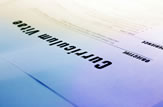Tips for targeting your resume in your job search
By Heather Keeping
 Job search resume tips can be overwhelming. When looking at resume tips for your job search, you need to sort through a lot of information and advice available about how to effectively write a resume. It can be difficult to sort through what is someone’s opinion and what is useful information to help you make the most of your job applications.
Job search resume tips can be overwhelming. When looking at resume tips for your job search, you need to sort through a lot of information and advice available about how to effectively write a resume. It can be difficult to sort through what is someone’s opinion and what is useful information to help you make the most of your job applications.
A resume serves as a self-marketing tool. It’s an important piece of paper, as it is sometimes the only thing the employer sees when trying to assess if you are one of the top candidates they want to interview. The purpose of the resume is to get you an interview. Once you get the interview, you can focus on landing the job – but you need to get there first!
Job search resume tips
Relevance
There are several key points that are important to consider when building an effective resume. First, your resume needs to be relevant to the employer. A common mistake that job seekers make is to include everything about themselves, their work history, and their skills. While you want to give a full picture of who you are to the employer, it’s not about giving them every little detail; it’s about giving the most relevant details. Think of a job opening as a puzzle piece. For the employer, that piece is missing from their company’s ‘puzzle’, and they need to find the best fit for that position.
Researching your target
To really target your application to what the employer wants, you need to learn as much as you can about the position and the company. Use your contacts, the job posting and the company’s website to help you research and identify what key qualifications, skills, and experience are the best match for the employer. Then incorporate this information into your resume, allowing the employer to see how you are a great match for them! There are two benefits to this approach – it allows you to show the employer how you are the best ‘fit’ for their ‘puzzle’, and it shows the employer that you are really interested in this particular opportunity, rather than any job you can find.
Skills summaries
Another effective strategy is to prioritize the information on your resume so that the most relevant details are readily accessible to the employer. A “skills summary” section at the top of your resume is a great way to focus in on the details of most relevance to the employer, without having to make drastic changes to your resume for each different application you prepare. This section should highlight the main skills, experience, and qualifications you have (and that aren’t necessarily attached to one particular position). One example of an effective bullet in a skills summary might be: “Exceptionally well-organized Administrator with seven years of experience”. Some people also use a career profile.
Bullets and action statements
Using bullets is another great strategy in effective resume writing. While you can write a resume without them, bullets tend to make your document more focused and easier to read. Use bullets in your “skills summary” to point out exactly what you have to offer this employer that makes you the best person for the job. Then use them in any description you are including for your past positions. In these sections, you want to make each bullet or statement “action oriented”. This means that it should outline what you did, how you did it and what skills you used or developed. These details paint a much clearer picture of your qualifications as a candidate than a general statement would. For example, compare the effectiveness of a statement such as “excellent sales skills” as opposed to “exceeded sales targets by using sales and persuasion techniques to sell as many items as possible”. And by using bullets, you can ensure that each point on your resume is relevant to the employer. They also make your document more visually accessible to the reader, as a few bullet points are easier to scan than a full paragraph.
Format and finishing touches
Because your resume is a self-marketing tool, you want it to look polished and professional if it’s going to make a positive first impression. To accomplish this, your resume, and any corresponding documents such as a cover letter or reference list, should all display your name and contact information in an attractive and professional style. You can consider this your personal letterhead – just like a company will “brand” their documents with a letterhead, you can apply this to your job search documents. You also want to ensure that you use a consistent font and size in your document, and that your headings are easy to locate on the page. When complete, proofread your document for clarity, spelling, and grammar and, if possible, have another person proofread it as well. Finally, if sending your application by email, make sure you make it clear what for position you are applying — and save your resume under a clear file name, such as “M Smith Resume”.
Remember – a resume is a living document. It is most effective to adapt it to different job applications, in order to highlight the best about you for that particular position. By focusing in on what the employer is looking for, and how your skills and experience are a match for that, you are putting yourself in the best possible light to be the ‘missing piece’ for the employer’s puzzle!
Related to Job Search Resume Tips



